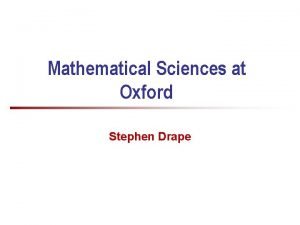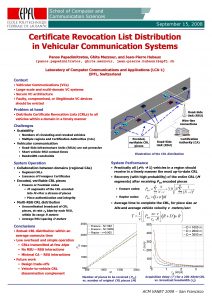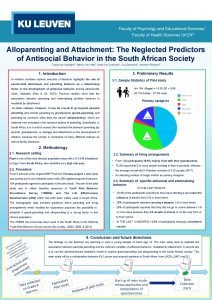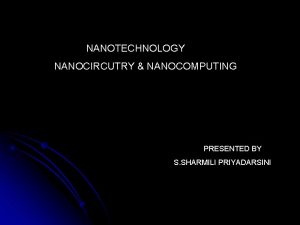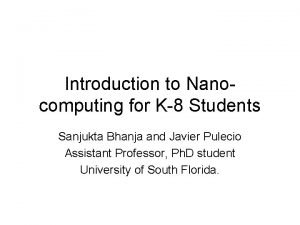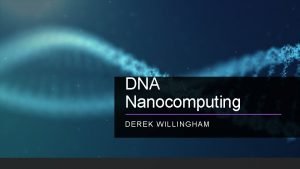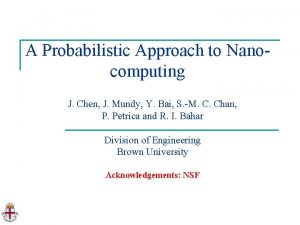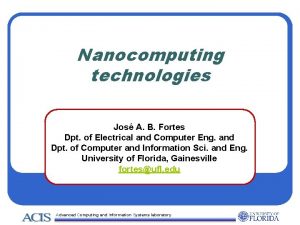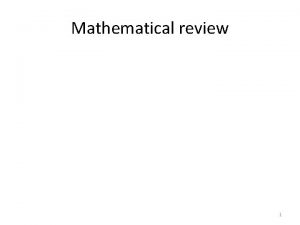School of Mathematical Sciences Nanocomputing memory devices and






















- Slides: 22

School of Mathematical Sciences Nanocomputing memory devices and logic gates formed from carbon nanotubes and metallofullerenes Nanomechanics Group, School of Mathematical Sciences, The University of Adelaide, SA 5005, Australia Richard K. F. Lee and James M. Hill 5 th – 9 th February 2012 ICONN 2012, Perth, Western Australia Life Impact The University of Adelaide

Overview • Trends in computer requirements: – Smaller in size, – Faster processing, – Increased data capacity. • Nano memory devices and logic gates: – Continuous approximation, – Lennard-Jones potential, – Memory devices and logic gates. • Conclusion 2

COMPUTER SIZE AND SPEED 3

DATA STORAGE Floppy Disk Punch Card Magnetic Tape Media (Data Size): Floppy Disk (360 KB ~ 1. 44 MB) ZIP Disk (100 MB ~ 750 MB) CD/DVD/Blue-Ray (640 MB ~ 50 GB) Hard Disk (30 MB ~ 3 TB) 1 TB=1024 GB 1 GB=1024 MB 1 MB=1024 KB 1 KB=1024 B 4 Hard Disk

Interaction energy between two molecules • The non-bonded interaction energy is obtained by summing the interaction potential energy for each atom pair • In continuum models, the interaction energy is obtained by averaging over the surface of each entity. where h 1 and h 2 are the mean atomic surface densities for each molecule, and r is the distance between two surface elements d. S 1 and d. S 2 on two different molecules.

Lennard-Jones Potential : well depth, : van der Waals distance rmin = 21/6, Fmin = - • • The repulsive term 1/r 12, dominates at short distances, The attractive term 1/r 6, dominates at large distances (weak interaction), Each atom-atom interaction is characterised by two Lennard Jones constants, A=4 es 6 and B=4 es 12 determined experimentally, and using empirical combining rules, e 12=(e 1 e 2)1/2, s 12=(s 1+s 2)/2, Force: F=-d. F/dr.

Lennard-Jones sphere-point interaction “Father of modern computational chemistry” • • (October 27, 1894 – November 1, 1954) Mathematician who held a chair of Theoretical Physics at Bristol University (1925 -32) Proposed Lennard-Jones potential (1931)

Nano memory devices (1) (2) Large energy gap (~7 e. V) Small energy gap (~1. 1 e. V) (2) Originally proposed by Y-K Kwon, D Tománek and S Iijima (1999) using MD Simulations

Nano memory device (1) Changing State External E field Y. Chan, R. K. F. Lee, and J. M. Hill, “Metallofullerenes in composite carbon nanotubes as a nanocomputing memory device”, IEEE Transactions on Nanotechnology, 10 (2011) 947 -952.

Nano memory device (1) Metallofullerene (0, 0, Z) Smaller Nanotube (rcosf, rsinf, z) Larger Nanotube (Rcosf, Rsinf, z) Distance for the center of the metallofullerene and Smaller Tube: rt 2=r 2+(Z-z)2 Larger Tube: r. T 2=R 2+(Z-z)2 • E = Em-T 1+Em-t+Em-T 2 + Ef-T 1+Ef-t+Ef-T 2 • F = Fm-T 1+Fm-t+Fm-T 2 + Ff-T 1+Ff-t+Ff-T 2

Energy Detail: K+@C 60 L 1=20Å r=6. 093Å R=6. 766Å Egap Emin State |0> State |1>

Force Fcritical Detail: K+@C 60 L 1=20Å r=6. 093Å R=6. 766Å Fcritical State |0> State |1>

Nano memory device (2) Changing State External E field R. K. F. Lee, and J. M. Hill, “Design of a two-state shuttle memory device”, CMC: Computers, Materials and Continua, 20 (2010) 85 -100.

Ion K+ FMg 2+ Cl. Cl. Na+ Na+ Li+ I- r 0(Å) 4. 0010 2. 495 0. 7926 0. 9929 1. 0600 2. 4192 4. 40 4. 05 4. 45 3. 33 2. 43 2. 58 2. 224 4. 286 Different Ion @C 60 for nano memory device (2) e(me. V) 3. 0352 0. 403 38. 798 37. 944 4. 336 4. 332 6. 509 4. 622 0. 124 2 a. 031 0. 643 13. 429 10. 149 l(Å) 7. 23235 7. 23482 7. 23466 7. 23454 7. 23449 7. 23422 7. 23075 7. 23093 7. 23045 7. 23478 7. 23450 7. 23472 7. 23381 7. 22895 Emin(e. V) -4. 39478 -4. 36394 -4. 36577 -4. 36724 -4. 36783 -4. 37120 -4. 41539 -4. 41263 -4. 41925 -4. 36449 -4. 36787 -4. 36524 -4. 37614 -4. 43797 l=L+r-Zmin Egap(e. V) Fcritical (e. V/Å) 1. 13255 0. 46929 1. 12464 0. 46615 1. 12517 0. 46635 1. 12556 0. 46651 1. 12572 0. 46657 1. 12655 0. 46691 1. 13776 0. 47136 1. 13713 0. 47111 1. 13873 0. 47174 1. 12477 0. 46620 1. 12568 0. 46656 1. 12498 0. 46628 1. 12787 0. 46734 1. 14357 0. 47367 Mass(u) 39. 102 19. 00 24. 31 35. 453 22. 990 6. 941 126. 90

Transfer time for nano memory device (2) Example: K+@C 60 2 L=27Å, Fext=0. 5 e. V/Å tf=2. 4933 ps (1 ps=10 -12 s) State Switching Rate ~ 401 Gbit/s

Nano logic gate Input Output I 1 I 2 AND OR NAND NOR T T F F T T F F F T T T = TRUE F = FALSE R. K. F. Lee, and J. M. Hill, “Design of a nanotori-metallofullerene logic gate”, (2011), submitted to IEEE Transactions on Computers.

Nano logic gate Maximum energy – Minimum energy < 0. 011 e. V


Conclusion • Memory devices and logic gates: – Nano size, – Electrical field control. • For a fast state switching rate / time: – Light Ion, – Large external force, – Short nanotube length, – Around 400 Gbit/s.

Acknowledgement • All colleagues in the Nanomechanics Group • Australian Research Council http: //www. maths. adelaide. edu. au/nanomechanics/ 20

Thank you! http: //www. maths. adelaide. edu. au/nanomechanics/

References • G. E. Moore, Technical Digest International Electron Devices Meeting, 21 (1975) 11 -13. • B. J. Cox, N. Thamwattana and J. M. Hill, Proceedings of The Royal Society A, 463 (2007) 461 -476. • B. J. Cox, N. Thamwattana and J. M. Hill, Proceedings of The Royal Society A, 463 (2007) 477 -494. • Y. Chan, R. K. F. Lee and J. M. Hill, IEEE Transactions on Nanotechnology, 10 (2011) 947 -952. • R. K. F. Lee and J. M. Hill, CMC: Computers, Materials and Continua, 20 (2010) 85 -100. • R. K. F. Lee and J. M. Hill, “Design of a nanotori-metallofullerene logic gate”, (2011), submitted to IEEE Transactions on Computers.
 Human science tok
Human science tok Mathematical sciences oxford
Mathematical sciences oxford What is mathematical economics
What is mathematical economics Internal memory and external memory
Internal memory and external memory Primary memory and secondary memory
Primary memory and secondary memory Page fault
Page fault Rmit chiropractic
Rmit chiropractic School of exercise and nutrition sciences
School of exercise and nutrition sciences School of computer and communication sciences
School of computer and communication sciences Episodic memory vs semantic memory
Episodic memory vs semantic memory Implicit explicit memory
Implicit explicit memory Long term memory vs short term memory
Long term memory vs short term memory Physical memory vs logical memory
Physical memory vs logical memory Which memory is the actual working memory?
Which memory is the actual working memory? Virtual memory in memory hierarchy consists of
Virtual memory in memory hierarchy consists of Eidetic memory vs iconic memory
Eidetic memory vs iconic memory Shared memory vs distributed memory
Shared memory vs distributed memory Queens high school for the sciences at york college ranking
Queens high school for the sciences at york college ranking Beulah school of natural sciences
Beulah school of natural sciences Psycholgy
Psycholgy What are the poetic devices
What are the poetic devices What are input devices and output devices
What are input devices and output devices #shortterm
#shortterm

